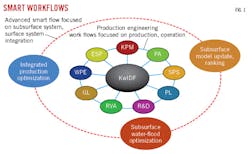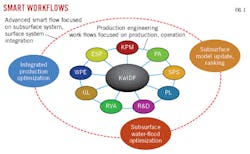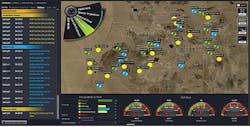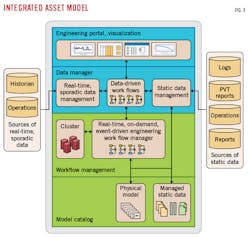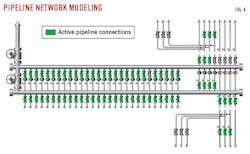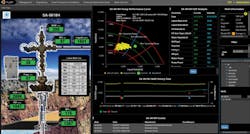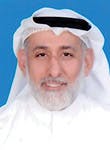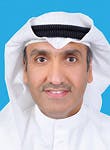KOC’s digital oil field initiative increases North Kuwait production
Hatem Nasr
Kuwait Oil Co.
Houston
Hamad Al-Zaabi
Ahmed Khalid Al-Jasmi
Mohammed Al-Hamer
Kuwait Oil Co.
Kuwait City
Kuwait Oil Co. (KOC) plans this year to start Phase 2 of Kuwait’s Integrated Digital Oil Field (KwIDF). The Phase 1 rollout and expansion, covering nearly 1,200 wells, began in 2015 with completion in 2017.
KwIDF’s implementation serves as a model for digital oil field applications beyond Kuwait to conventional and unconventional fields worldwide. KOC successfully integrated operations involving real-time surveillance, modeling, and optimization of oil field assets. Application of digital surface and subsurface technologies has changed how KOC engineers and managers perform daily operations.
During the pilot, KOC increased oil production by more than 5% and improved overall efficiency through automated work processes and shorter observation-to-action cycle times. Engineers gather real-time information from wells and pipelines in a multi-disciplinary, collaborative setting.
KOC’s Research and Technology (R&T) Group sponsored the pilot initiatives, targeting three KOC assets for pilot projects: North Kuwait (NK), Jurassic gas, and Southeast Kuwait Gathering Center 1 (GC1).
This article focuses on the NK asset, which presented some complex reservoir and production issues. Halliburton Corp. initially deployed KOC’s NK KwIDF pilot in 2009 starting with 49 wells and expanding to 140 wells during 2012-14.
The pilot demonstrated tangible benefits despite its limited scope considering the size of the NK asset. KOC has completed a full-scale rollout of KwIDF to the NK asset.
Weekly production increased by thousands of barrels, but specific numbers are unable yet because validation takes time to factor in reservoir decline.
Digital transformation
Digital transformation is an imperative, core KOC strategy. Industry has various definitions for a digital oil field. KOC defines digital oil field as an integrated system for:
• Deployment of smart measurement and control systems in subsurface and surface wells, network, and facilities.
• Capture and integration of real-time surface and subsurface data.
• Intelligent information processing using an integrated asset model and smart work flows for smart surveillance, control, diagnostics, optimization, and prediction.
• Enabling collaboration to enhance knowledge-based growth and make better decisions.
KOC’s KwIDF goal is to forecast and optimize production, enhance operational performance, maximize recovery, and improve health, safety, and environment (HSE) standards.
NK experienced dropping reservoir pressure, displacement inefficiency, and increased water levels. The KwIDF project sought to deal with those issues as well as improving recovery factory and optimizing electric submersible pump (ESP) performance.
The NK KwIDF pilot focused on Sabriyah Mauddud field, a giant water-flooded oil reservoir. Initially, KOC installed wireless communication to allow real-time broadband connectivity with all wells.
KOC also installed supervisory control and data acquisition (SCADA) instrumentation on all wells. During the pilot, KOC developed several advanced workflows to process real-time well data for comparison with historic data.
Fig. 1 shows nine workflows focused on well surveillance and production operations. These workflows enable short-term decisions using real-time data to improve well performance, reduce well downtime, and improve field performance. The nine are:
• Key-performance monitoring (KPM).
• Well-performance evaluation (WPE).
• Smart production surveillance (SPS).
• Production losses (PL).
• Reservoir visualization and analysis (RVA).
• ESP diagnostic, optimization.
• Production allocation (PA).
• Gas-lift optimization (GL).
• Reporting and distribution (R&D).
Fig. 2 shows a screen shot featuring an ESP work flow. KOC also developed two work flows focused on mid-term and long-term reservoir planning and management: subsurface waterflood optimization and subsurface model update and ranking.
Halliburton and KOCengineers jointly designed smart work flows as shown in a screen shot of the electric submersible pump diagnostic and optimization process during a pilot (Fig. 2).
KwIDF expansion
The NK expansion project encompasses five oil fields: Sabriyah, Raudhatain, Ratqa, Abdali, and Bahra with five gathering centers (GC15, GC23, GC24, GC25, and EPF120), covering nearly 1,200 wells, and 97 injectors.
The asset includes nearly 785 ESP wells, 14 gas-lift wells (being phased out), more than 220 naturally flowing wells, and less than 20 progressive cavity pump and sucker rod pump wells.
A steering committee composed of high-level managers and team leaders from across KOC supervised the expansion’s progress. Representatives from Halliburton and Petroleum Experts (Petex) worked closely with KOC engineers during the design, implementation, testing, and validation phases. The effort invlved:
• Connecting all the wells with the KwIDF system.
• Building an integrated asset model (IAM) covering all wells and the entire pipeline network.
• Upgrading the information technology (IT) infrastructure to accommodate an expanded scope and ensure future growth capabilities.
• Integrating multiple data sources, such as real-time SCADA (wellhead instrumentation and ESP data), drilling data, water-injection data, corporate database, and well-surveillance data.
• Transitioning and upgrading several workflows developed during the pilot.
• Developing several new advanced dashboards for management and engineers.
IAM, well modeling
The IAM involved building physical models of all wells and the pipeline network to predict, manage, and audit system performance.
Fig. 3 shows the Petex IAM architecture, which can handle multiple well and fluid types. It provides the ability to model an entire field, performing rapid calculations to help engineers optimize well and pipeline network performance.
The IAM is used to predict and optimize oil production for all wells and the pipeline network. The IAM also allows engineers to automate tasks that include updating well models, running sensitivity cases, and implementing complex workflows.
The IAM’s objectives were to:
• Understand field performance through monitoring, surveillance, and diagnostics.
• Create models that reproduce operating situations.
• Improve field performance through optimization and debottlenecking.
A major component of the Petex IAM system is a real-time advanced well surveillance (AWS) model. It provides real-time production rates, sensitivity to input data, wellbore pressure and temperature-gradient calculations, deviations between measurements and calculations, well-drainage-area pressure estimates, and a well-productivity estimation productivity index (PI) at original reservoir pressure.
IAM also provides well performance based on any external rate measured (e.g. multi-phase metering) and overall well key performance indicators (KPIs) based on deviations among different rate methods to highlight wells and models requiring attention.
IAM supplies real-time analysis on possible changes in well production, vertical lift performance and inflow performance relationship (VLP-IPR) plots, well gradient plots, daily average well rate calculations, and real-time reservoir void rates with dynamic pressure-volume-temperature (PVT) calculations.
Petex also built a comprehensive network model for more than 4,000 pipelines plus manifolds and gathering centers. Fig. 4 shows the pipeline network model, which is a highly complex network involving many pipeline segments and route combinations.
Dashboards, work flows
KOC and Halliburton jointly designed several new smart dashboards that Halliburton implemented in the expansion phase. Management-level dashboards provide a quick overview of the asset’s status. Several other dashboards were designed for engineering-level analysis.
Three management level dashboards provide an asset level summary, a field production summary, and a gathering facilities summary.
These dashboards automatically gather data daily from across multiple systems, perform calculations, and provide KPIs so managers and engineers can quickly analyze asset conditions and make informed decisions.
A field summary dashboard provides highlights of daily production across the NK asset at the gathering system level, oil rates from the models, gas-oil ratio (GOR) well testing, daily gains and losses, water-injection rate, and active producers and injectors and drilling rigs in each field.
All dashboards have filters that allow users to select a field or gathering system by specific time and by reservoir. Users can generate detailed reports for each indicator such as a well’s production gain and losses.
Nine engineering-level dashboards provide detailed production analysis, water injector analysis, well events, drilling status, and artificial lift analysis. For example, the water injection dashboard provides daily injection rates, allowable injection rates, the number of active injectors, water-oil ratio (WOR), and other KPIs.
Water injections dashboards separately provide details about levels of effluent water injection, seawater injection, and voidage replacement ratios. Users also monitor water injection data in different reservoirs by observing pressure maps and structural maps.
KOC and Halliburton also designed and implemented workflows that integrate data from multiple sources. These workflows enable smart surveillance, analysis, diagnostics, and optimization.
Most producing wells have ESPs, making the ESP workflow one of KwIDF’s most important tools. The workflow has three components:
• ESP status summary that provides an overview of the conditions and KPIs of all ESP wells (shown by asset level or by field level).
• ESP well analysis that provides detailed information about a given well.
• ESP optimization that makes recommendations and allows users to envision various scenarios.
An ESP summary view provides several ESP-related KPIs. The ESP workflow lists increased production opportunities in various ESP wells daily. The workflow incorporates smart algorithms that use real-time data and well models from the Petex system to rank optimization opportunities.
For each of the 700 ESP wells, the system provides potential oil gains and makes recommendations such as changes in pumping frequency or wellhead pressure. This saves time for engineers who would otherwise manually perform these tasks.
The workflow also tells engineers whether wells are in up thrust or down thrust, which indicates whether ESP size is adequate.
Engineers assess the ESP workflow and then analyze each option before making a final decision. Fig. 5 shows an ESP optimization screen shot, which displays the pump curve that shows the pump head vs. liquid rate at various frequencies.
KOC engineers use a dashboard providing electric submersible pump information as part of the company’s emerging digital oil field strategy (Fig. 5).
It also shows potential opportunities (yellow dots), current operating points (green dots), and recommended settings (blue dots). The recommended ESP frequency will result in higher production.
Artificial-lift specialists instantly can view the potential outcome of total liquid rate, oil rate, water rate, and other parameters. Engineers also observe real-time well conditions given surface and subsurface parameters. This detailed analysis allows engineers to finalize well-control decisions.
Increased Production
Several case studies show clear results from three sample wells where the KwIDF system contributed to increased daily oil production. For instance, the optimization results of wells SA-209H, SA-0298, and SA-0618 in Sabriyah field have resulted in 4-5% production increases.
During weekly meetings, the KwIDF unit members review a wide range of optimization opportunities generated by the KwIDF system’s ESP workflow.
Different engineers are assigned different sets of wells. Beyond the automated work flow, engineers consider many other elements, including the latest well tests, reservoir conditions, pump capacity, and motor capacity.
Once the optimization options are selected, an automated system generates a ticket. The operations and well-surveillance groups also review the recommendations before implementation.
KOC formed a dedicated KwIDF unit. This unit has representation from across KOC’s field development group, operations group, IT group, well surveillance group, water-handling group, and other organizations.
The KwIDF unit’s mission is daily and weekly analysis to identify optimization opportunities and communicate recommendations. It also trains engineers on the system and coordinates with technology providers about system maintenance and enhancements.
As of late May 2018, KOC was preparing to launch an advanced business process management (BPM) system that will automate the tasks of generating an opportunity, communicating that opportunity to interested parties, and getting approvals.
Phase 2 focus
NK asset issues yet to be addressed are waterflood management, production loss from ESP failures due to unplanned tripping events, pipeline network optimization, flow assurance, and operational performance.
During KwIDF Phase 2, KOC wants to leverage recent industry advancements in subsurface measurements and surveillance, artificial intelligence (AI), and the internet of things (IoT).
KOC’s R&T group will lead Phase 2 and supervise the deployment of several new technologies and solutions. These will focus on:
• Improved reservoir surveillance and characterization using far-field resistivity, near-wellbore sensors, such as distributed fiber-optic sensors, and other subsurface measurements.
• Enhanced artificial lift performance specifically targeted towards predictive analysis using AI and building data-driven models to predict ESP failures and unplanned shutdowns.
• Integrated production optimization workflow that can integrate reservoir, wells, pipeline network, and facilities models.
• Advanced asset monitoring deploying new-generation IoT sensors and automation technology across the wellheads and pipeline network points. IOT devices will be capable of edge computing (at the well level) for smart diagnostics and failure prediction.
The authors
Hatem Nasr ([email protected]) is senior advisor for KOC’s KwIDF projects. He helped develop KwIDF from inception, including design to system architecture, to implementation and oversees business process management. He has 15 years of experience working on digital oil field projects. Previously, he cofounded vMonitor Inc., which Rockwell Automation acquired. vMonitor specialized in automation technology for digital oil field applications. Nasr also worked as a Baker Hughes Inc. technology director. He has a PhD (1988) from the University of Minnesota.
Hamad Al-Zaabi ([email protected]) is team leader of field development North Kuwait Sabriyah field. Having joined KOC in 1993, he previously was team leader in the R&T Information Management Group where he led development of a data management system. He was instrumental in managing and directing the Phase 1 KwIDF expansion project to cover the entire NK asset. He received a petroleum engineering degree (1992) from the University of Louisiana.
Ahmad Khalid Al-Jasmi ([email protected]) is KOC’s team leader for new fields development (North Kuwait). During his leadership, oil production has tripled in this KOC unconventional asset. He was instrumental in initiating three KwIDF pilot projects, leading them from concept through implementation. He joined KOC in 1992. He published several technical papers about digital oil field and advanced technology implementation. He received a BS (1991) in petroleum and natural gas engineering from Pennsylvania State University.
Mohammed Al-Hamer ([email protected]) is KOC’s senior petroleum engineer. He was named KwIDF leader of the NK asset in 2010, during which time he expanded work from the pilot to all NK wells and facilities (around 1,100 wells and five gathering centers). He joined KOC in 2004 as a petroleum and reservoir engineer. He received a BS (2003) in petroleum engineering from the University of Kansas and an MS (2009) in petroleum engineering from Heriot-Watt University, Scotland.
